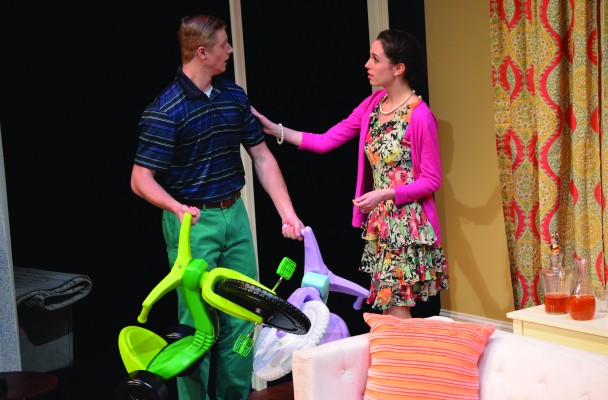“Cul-De-Sac” explores the human search for happiness

The Jones Family, played by Matthew Hollis and Lauren Quintal. Photo by Deja Ross.
By Sam Rakestraw, Staff Writer//
On April 17, the Department of Theatre and Dance closed the curtains of their 2015-2016 season with showings of John Cariani’s play “Cul-De-Sac.” The play ran from April 14-17. Students and theatre enthusiasts of the Triad area were invited to attend the production over the weekend.
The playwright’s successful stage career doesn’t just revolve around his writings but in addition, Cariani has won acclaim for his own performances in stage and film, the most notable being a Tony nomination for his involvement in a 2004 Broadway revival of “Fiddler on the Roof.” His first play, “Almost, Maine,” has become one of the most produced stage productions in the United States.
High Point University’s “Cul-De-Sac” featured a cast of Alpha Psi Omega honorary theatre fraternity members. The plot revolves around the lives of three suburban families living in a, you guessed it, cul-de-sac. The three families include Diane and Brian Johnson (played by Roxanne Daneman and Jordan Dallam), Christy and James Smith (played by Summer Kiesel and Patrick Kinsella-McClelland), and Irene and Joe Jones (played by Lauren Quintal and Matthew Hollis). In short, these three couples are neighbors, and the play almost seems to split into three snippets of their home lives.
The common theme that ties them all together, aside from living next to each other, is their common drive to find complete happiness. The debate of true contentment is the underlying theme in the play as we see each of the couples lament on their personal belief on what it is and how they can reach it. “Cul-De-Sac” ultimately seems to parody the idea of the American mythology of “the pursuit of happiness.” Each of the families have the most basic and common of last names; Johnson, Smith, and Jones.
The play doesn’t try to amplify the characters or set any of them as the main focus, it found a way to get them all on the same level and giving them almost equal spotlight. The story goes that Irene and Joe Jones are the happy family on the block. Their neighbors, the Smiths and Johnsons, look upon them with envy and throughout the play lament separately on their own takes of true happiness, which they have not yet reached. The set could be described as thought provoking, a bit eccentric and, in some areas, a little dark.
“Cul-De-Sac” takes all these emotions that seemingly don’t connect, mixes them together and somehow manages to make them work, for better or worse. Daneman and Dallam played the Johnsons, who, in a way, represented the family wherein something is missing and finding it will bring happiness. This duo did an impressive job of displaying this. You see them in the second scene of the play in their home. Their search eventually did end, in the most unorthodox and macabrely satisfying way.
The Smiths were the next in the spotlight. Kiesel and Kinsella-McClelland played the neurotic and skeptical couple. Their performance in displaying nervousness and awkwardness rakes in a certain degree of emotion from the audience, meaning they were able to pull it off without looking too forced. As the audience, you can’t help but hope for people so nervous to find peace and for it to all work out for them in the end. Like the Johnsons, they were able to pull through, and from their jitteriness arose the confidence to make changes in order to find their personal happiness.
Change is the key word when the dynamic of the Jones are explored in the ending moments of the play. It seemed from the beginning that they were ahead of their neighbors, they had achieved happiness and there was nothing left to do but to show it off. They live their lives on a regimen, unwilling to bend to the ever changing world around them as it may derail them from their happiness. Eventually, the metaphorical change caught up with them and the Jones begin to have a breakdown, much like their neighbors. Quintal and Hollis were tasked with beginning in an overly jittery seemingly perfect couple while ending in more darker and serious reality. Nonetheless with character development that was sporadic, their transition was emotionally distancing and well carried out as it could be.
At the end of the day, “Cul-De-Sac” was a thought-inducing experience in a play with exceptional production values, writing where every dialogue was an intense mental game of ping pong between the characters and some compromising positions the audience could relate to.